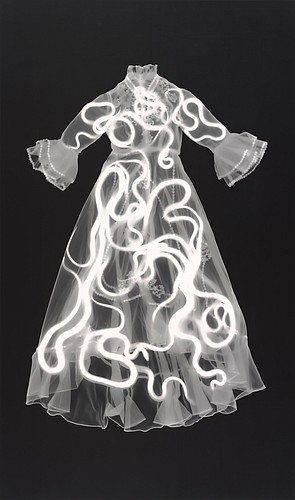- May 3, 2025
-
-
Loading

Loading

On display in a jeweler’s case, an array of gaudy jewelry glimmers beneath the bright showroom lights. The watches, necklaces and bangles, all generously encrusted with diamonds, conjure images of a flashy mobster preparing for a night on the town.
A closer look reveals a different story. The shimmering diamonds are actually tiny shards of broken glass — broken glass from drug-cartel drive-by shootings in Culiacán, Mexico, to be precise. And the placards next to each item don’t list a price or describe the jewelry. Rather, they quite plainly state the details surrounding the particular murder.
Mexican artist Teresa Margolles created the display for her conceptual piece, “Score Settling.”
As the reality of the display sets in, one can’t help but feel the emotional weight of the violence — and the physical presence of the victims.
It’s a difficult feeling to pinpoint, but this phenomenon is the unifying theme of “Phantom Bodies: The Human Aura in Art,” a new, evocative exhibition currently on display at The Ringling.
Originally curated by Mark Scala, at the Frist Center for Visual Arts, in Nashville, and now on display at The Ringling, the contemporary group exhibition contemplates art’s ability to evoke the human presence, even in its absence.
“I was intrigued by the way these objects stimulate certain memories or feelings,” says Matthew McLendon, curator of modern and contemporary art, who oversaw the local installation. “Many of the pieces themselves are objectively beautiful, but they’re also profoundly intellectual. The sense that the human presence is embedded into the work is quite powerful.”
The exhibition explores the relationship between mind, body and spirit through a collection of 38 paintings, photos, videos, sculptures and installation pieces. The works are loosely divided into four subsections: “Objects and Absences,” “Violence, Empathy and Erasure,” “Sublimation” and “The Mind-Body Problem.”
Work from leaders in the contemporary art world, including Margolles, Damien Hirst, Christian Boltanski, Anish Kapoor and others, each tackle the subject from a different angle. Much of the work is heavy.
Doris Salcedo’s “Atrabiliarios,” for example, features found shoes, worn by women who have gone missing. The shoes are recessed into the wall and obscured by an animal-skin covering, sewn to the wall.
Historic lynching photos have been edited to remove the victims, leaving behind only the perpetrators of the violence and its onlookers in a haunting display.
But not all of the pieces take a somber tone. One of the final pieces in the exhibition, Damien Hirst’s “The Unbearable Lightness of Being,” is a huge, 96-inch- by-60-inch mandala, created with the shimmering wings of butterflies.
McLendon says the piece is his personal favorite, and that it serves as an uplifting punctuation to the experience.
“It reminds you of the beauty — and fragility of life,” he says. “Just being in the physical presence of these objects, you realize the power they can have over you. I hope people can leave with a sense of introspection. These works are salient in our time, and they help us better understand the world in which we live.”